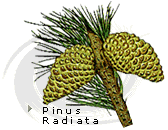 |
|
||||||||
|
|||||||||
|
 |
|
||||||||
|
|||||||||
|
 Radiata Pine Pinus radiata, vulgarly called pine insignis or Monterrey pine, is a pine whose natural area is reduced to less than 4000 ha from the coast. Nowadays it has been artificially introduced in the southwest of Europe (GALICIA - Lugo ...) New Zealand, Chile, South Africa, the southwest of Australia, exceeding the area, the million ha. In Spain it was introduced in all the Cantabrian Mountains, especially in Galicia (Lugo) and the Basque Country where two thirds of the entire pine insignis are concentrated. The pine insignis was first introduced in Spain in the middle of the XIX century by the illustrious dendrologist Carlos de Yarza and, in less than three-quarters of the century, the extension of this specie reached a quarter million ha. It is a tall tree that can easily reach 30m although its average height is 20m. Its appearance is regular, pyramidal in youth and finally broad, globoid or truncated. The trunk is right, quite conic, morphine coefficient at 25 years about 0.45 increasing with less quality of the mass; the morphine coefficient has no relation with mass density. It has vertical branches in the shape of horizontal candelabrum or erect, evident at the base, vertical and ascending at the ends, short in relation to internodes, giving the tree a characteristic aspect. The number of annual buds is two, although on occasions it can be more. The branches are quite persistent still with lack of light, therefore for its elimination it is not enough to look for the maximum thickness, but it is necessary to prune it artificially. While with the thickness the branches are not eliminated, it has influence on the development and thus in the size of wood knots The distance among branches varies according to the soil conditions, nevertheless an average of about half a meter can be established. This distance can be modified with the thickness of the mass in about 20% being the greater the thickness the greater the internode. |
| 3/4/2014 5:35:36 PM |
|
| Rama Forestry Project - Estancia Rama - Provincial Route 9 Km. 72 - Valle of Pancanta -
(5701) San Luis - Argentina / TE: +54 2652 447480 / +54 2652 452000 ext 4308
rama@rama.com.ar
| |